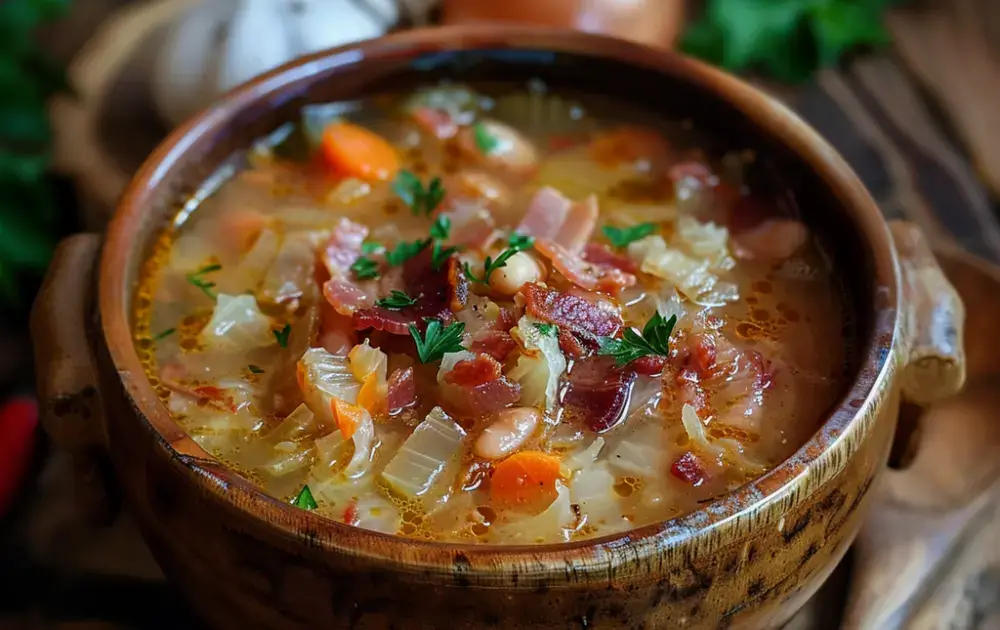Sauerkraut Soup, a staple in Eastern European cuisine, offers a unique blend of tangy, savory, and comforting flavors. This hearty soup combines the probiotic-rich sauerkraut with a variety of meats, vegetables, and spices, creating a dish that’s not only satisfying but also packed with nutritional benefits. It’s a perfect meal for cold weather, bringing warmth and comfort with every spoonful.
Selecting the Right Ingredients
The key to a flavorful Sauerkraut Soup lies in the quality of its ingredients:
- Sauerkraut: Choose naturally fermented sauerkraut for its probiotic benefits and depth of flavor.
- Meat: Smoked meats like sausage, ham, or bacon add a rich, savory taste. For a lighter version, chicken or turkey can be used.
- Vegetables: Potatoes, carrots, and onions form the vegetable base, adding sweetness and body to the soup.
- Spices: Bay leaves, paprika, and black pepper are essential for achieving the authentic taste of the soup.
Preparing the Base
Start by sautéing diced onions in a bit of oil until they’re translucent. Add your choice of meat to the pot and cook until browned. This step not only renders the fat from the meat, adding richness to the soup, but also builds a flavor foundation that’s crucial for the overall taste.
Incorporating Sauerkraut and Vegetables
Once the meat is browned, stir in the sauerkraut, allowing its tangy flavor to meld with the meat. Add diced potatoes and carrots, covering them with enough water or broth to create a hearty soup. The vegetables will soften as they cook, contributing to the soup’s texture and flavor.
Simmering to Perfection
Bring the soup to a boil, then reduce the heat and let it simmer. Add bay leaves, paprika, and a generous grinding of black pepper. The simmering process allows the flavors to deepen and meld together, creating a harmonious and comforting dish. Adjust the seasoning to taste, keeping in mind the sauerkraut’s natural saltiness.
Serving Suggestions
Sauerkraut Soup is traditionally served hot, with a dollop of sour cream and a sprinkle of fresh dill or parsley for added freshness. Rye bread or crusty rolls make excellent accompaniments, perfect for dipping into the soup and soaking up its flavorful broth.
Customizing Your Soup
Sauerkraut Soup is incredibly versatile, allowing for various adaptations to suit dietary preferences or ingredient availability. Vegetarians can omit the meat and use vegetable broth, adding mushrooms for umami depth. For those who prefer a thicker soup, a tablespoon of tomato paste or flour can be added to the sautéing onions for a richer broth.
Sauerkraut Soup embodies the essence of comfort food, with its rich flavors, nutritional benefits, and the warmth it brings to the table. Whether enjoying a quiet meal at home or sharing with loved ones, this soup offers a taste of Eastern European tradition that’s both nourishing and delightfully satisfying.
Exploring the Health Benefits of Sauerkraut
Sauerkraut, the star ingredient of Sauerkraut Soup, is not just known for its distinctive tangy flavor but also for its health benefits. Rich in probiotics, vitamins C and K, and dietary fiber, sauerkraut supports digestive health, boosts the immune system, and may even contribute to improved mental health and wellness. Incorporating sauerkraut into this soup not only adds depth of flavor but also turns each bowl into a probiotic-rich meal that can aid in maintaining a healthy gut flora.
Balancing the Tang with Sweetness
The tanginess of sauerkraut can be quite pronounced, making it essential to balance the flavors in the soup. Adding a pinch of sugar or a splash of apple juice to the soup can counteract the acidity, introducing a subtle sweetness that complements the sauerkraut’s flavor. This balance is key to creating a soup that delights the palate with its complexity rather than overwhelming it with sourness.
Achieving the Perfect Consistency
The desired consistency of Sauerkraut Soup can vary from a light broth to a thicker stew. To thicken the soup, some cooks choose to add a roux made from flour and butter, cooked until golden before being stirred into the soup. Alternatively, allowing the soup to simmer uncovered for an additional period can naturally reduce and thicken the broth, concentrating the flavors and achieving a heartier texture.
The Role of Spices in Flavor Development
Spices play a crucial role in enhancing the soup’s flavor profile. Beyond the basic bay leaves, paprika, and black pepper, consider adding caraway seeds for an aromatic lift that pairs beautifully with sauerkraut. A touch of smoked paprika can intensify the smoky notes if using less meat, while a bay leaf contributes a subtle depth that rounds out the soup’s overall taste.
Serving with Traditional Accompaniments
While Sauerkraut Soup is a hearty meal on its own, serving it with traditional accompaniments can elevate the dining experience. A side of mashed potatoes, for instance, offers a creamy contrast to the soup’s complexity, while a simple salad dressed with a vinegar-based dressing can refresh the palate between bites. For an authentic Eastern European touch, consider offering a selection of pickled vegetables on the side, reinforcing the meal’s probiotic benefits and adding a crunchy texture contrast.
Sauerkraut Soup remains a beloved dish across Eastern Europe and beyond, celebrated for its unique combination of flavors, nutritional benefits, and comforting warmth. As a versatile recipe that welcomes customization, it invites cooks to experiment with ingredients and techniques to create a soup that reflects personal tastes while honoring the dish’s rich culinary heritage. Whether enjoyed as a winter warmer or a nourishing meal year-round, Sauerkraut Soup continues to satisfy and nourish in equal measure.
Incorporating Modern Twists
In the culinary world, tradition often meets innovation, and Sauerkraut Soup is no exception. Modern twists on this classic dish can include the addition of unconventional ingredients such as sweet potatoes for added nutrition and a hint of sweetness, or kale for a burst of color and a dose of greens. Some adventurous cooks might even add a splash of white wine for complexity or a dollop of pesto for a fresh, herby contrast. These updates can introduce new layers of flavor, making the soup even more appealing to contemporary palates.
The Art of Slow Cooking
Embracing slow cooking techniques can transform Sauerkraut Soup into a dish of unparalleled depth and richness. By allowing the ingredients to simmer gently over several hours, either in a slow cooker or on a low heat on the stove, the flavors meld and intensify, and the meat becomes exceptionally tender. This method not only enhances the taste but also fills the home with a comforting aroma, building anticipation for the meal to come.
Pairing with Beverages
Selecting the right beverage to accompany Sauerkraut Soup can enhance the dining experience. For a harmonious pairing, consider a crisp, dry white wine that can cut through the richness of the soup while complementing its tangy notes. Beer lovers might appreciate a light lager or pilsner, whose bubbly crispness pairs well with the soup’s depth. For a non-alcoholic option, a sparkling water with a squeeze of lemon offers a refreshing counterpoint to the soup’s savory flavors.
Celebrating Leftovers
Sauerkraut Soup is one of those dishes that many argue tastes even better the next day. The flavors continue to develop and meld, resulting in a richer, more cohesive dish. Embracing leftovers not only extends the enjoyment of the soup but also provides an easy, flavorful meal option for busy days. Simply reheat gently on the stove, adjusting the seasoning if necessary, and enjoy a comforting bowl of soup that’s as satisfying as when it was first made.
Sharing the Tradition
Cooking and sharing Sauerkraut Soup can be a meaningful way to connect with heritage and introduce others to the flavors of Eastern European cuisine. Whether it’s preparing the soup for a family dinner, a cultural celebration, or simply as a comforting meal for friends, the act of sharing this traditional dish fosters connections and creates memories. It’s an opportunity to celebrate the rich tapestry of culinary traditions that shape our world, one bowl of soup at a time.
Sauerkraut Soup, with its rich history and comforting flavors, continues to be a cherished dish across generations. Its versatility and nutritional benefits make it a timeless classic, while the opportunity for innovation keeps it relevant and exciting for today’s cooks. Whether enjoyed in its most traditional form or with a modern twist, Sauerkraut Soup remains a testament to the enduring power of good food to nourish, comfort, and bring people together.
Mastering the Soup’s Texture
Achieving the perfect texture in Sauerkraut Soup is a delicate balance. The potatoes should be tender but not falling apart, the meat succulent and flavorful, and the sauerkraut retaining a slight crunch. To ensure each component reaches its ideal texture, add ingredients in stages based on their cooking times. This methodical approach ensures that everything comes together harmoniously, offering a satisfying variety of textures in every spoonful.
Utilizing Fresh vs. Canned Sauerkraut
While fresh sauerkraut offers a crisp texture and vibrant flavor, canned sauerkraut can be a convenient and year-round alternative for making Sauerkraut Soup. If using canned sauerkraut, it’s important to rinse and drain it to remove excess brine, which can overly salt the soup. Regardless of which type you choose, adjusting the seasoning of your soup after adding the sauerkraut is crucial to achieving the perfect balance of flavors.
The Importance of a Good Broth
The broth serves as the foundation of Sauerkraut Soup, carrying the flavors of all the other ingredients. Whether you opt for a homemade stock or a high-quality store-bought version, choosing a good broth can significantly elevate the dish. For a deeper flavor, consider using a mix of chicken and beef broth, or add a piece of smoked meat to the pot while the soup simmers.
Garnishing for Enhanced Flavor and Presentation
A thoughtful garnish can transform Sauerkraut Soup from a simple meal to an elegant dish. A sprinkle of fresh dill or parsley adds a pop of color and a fresh flavor contrast to the soup’s richness. For a creamy element, a dollop of sour cream on top of each serving not only looks inviting but also adds a smooth, tangy note that complements the soup’s acidity.
Adapting Sauerkraut Soup for Health-Conscious Diners
For those looking to enjoy Sauerkraut Soup with a health-conscious twist, there are several adaptations that can lighten the dish without compromising its flavor. Opting for turkey sausage instead of pork, increasing the proportion of vegetables, and using a low-sodium broth are all effective ways to make the soup more nutritious. Additionally, serving the soup with a side of whole-grain bread can add fiber and nutrients to the meal.
Sauerkraut Soup’s enduring appeal lies in its complex flavors, nutritional benefits, and comforting warmth. As a dish that invites experimentation and personalization, it continues to delight diners with its unique taste and versatility. Whether enjoyed as a cozy meal on a cold day or as part of a festive holiday spread, Sauerkraut Soup remains a beloved classic, celebrated for its ability to bring people together over a shared love of hearty, flavorful food.
FAQs about Sauerkraut Soup
Can I make Sauerkraut Soup vegetarian?
Yes, you can easily make Sauerkraut Soup vegetarian by omitting the meat and using vegetable broth instead of chicken or beef broth. Consider adding more vegetables or some beans for added protein and texture.
How can I reduce the sourness of the sauerkraut?
If you find the sauerkraut too sour for your taste, you can rinse it under cold water before adding it to the soup. Additionally, a pinch of sugar or a splash of apple juice can balance the acidity without overpowering the soup’s flavors.
Is it possible to freeze Sauerkraut Soup?
Sauerkraut Soup freezes well. Cool the soup completely before transferring it to freezer-safe containers. It can be stored in the freezer for up to 3 months. Thaw in the refrigerator overnight and reheat on the stove over low heat, stirring occasionally.
What type of sauerkraut is best for the soup?
Naturally fermented sauerkraut, available in the refrigerated section of most grocery stores, is ideal for this soup due to its probiotic content and depth of flavor. However, canned sauerkraut can also be used if fresh is not available.
Can I add other vegetables to the soup?
Absolutely! Sauerkraut Soup is versatile, and adding other vegetables such as mushrooms, leeks, or spinach can enhance its flavor and nutritional value. Feel free to experiment with your favorite veggies.
Conclusion
Sauerkraut Soup stands as a testament to the rich culinary traditions of Eastern Europe, offering a comforting and flavorful experience that warms the soul. Its unique combination of tangy sauerkraut, hearty meats, and nourishing vegetables makes it a beloved dish among many. Whether you’re seeking comfort on a cold day, looking to explore international cuisines, or simply in need of a nutritious meal, Sauerkraut Soup delivers on all fronts. With the flexibility to adapt to various dietary needs and preferences, it continues to be a versatile and cherished recipe in kitchens around the world. Embrace the art of making Sauerkraut Soup and discover the joy of bringing this flavorful, comforting dish to your table.

Sauerkraut Soup
- Author: recipstep
- Total Time: 45 minutes
- Yield: 4 servings 1x
- Diet: Vegetarian
Description
Sauerkraut Soup is a hearty and comforting dish that combines the tangy flavor of fermented cabbage with a rich mix of meats, vegetables, and spices. Originating from Eastern Europe, this soup is a winter favorite, offering warmth and a wealth of nutritional benefits.
Ingredients
1 Tbsp olive oil
8 oz bacon, chopped
1 stick celery, finely diced
1 medium onion, finely diced
2 medium carrots, thinly sliced
3 medium potatoes (about 1 lb), peeled and sliced into 1/3″ thick pieces
1/4 cup quinoa, rinsed (optional)
2–3 cups sauerkraut, triple rinsed & drained (approximately 2 lbs)
8 cups low sodium chicken broth
2 cups water, or to taste
1 15 oz can white beans
1 bay leaf
Salt, Pepper, and Mrs. Dash seasoning, to taste
Instructions
Prepare Ingredients:
Heat 1 Tbsp oil in a large soup pot or Dutch oven.
Add chopped bacon and sauté until browned, then remove with a slotted spoon and reserve.
Add finely chopped celery and onion. Sauté until softened and golden (about 5 min).
Add sliced carrots, potatoes, 1/4 cup quinoa (if using), 8 cups broth, and 2 cups water. Bring to a boil then reduce heat and simmer for 15 min.
Add Sauerkraut and Beans:
Add 2-3 cups of well-rinsed and drained sauerkraut and half of the cooked bacon.
Include white beans with their juice and 1 bay leaf. Continue to cook until potatoes are tender (about 10 min).
Season and Serve:
Season the soup to taste with salt, pepper, and Mrs. Dash seasoning (adjust according to preference).
Serve hot with fresh crusty bread.
Optionally, garnish with reserved cooked bacon.
Enjoy your hearty Sauerkraut Soup!
Notes
- Rinsing the sauerkraut can reduce its sourness, but you can adjust this step based on your taste preference.
- For a vegetarian version, omit the sausage and use vegetable broth.
- Prep Time: 15 minutes
- Cook Time: 30 minutes
- Category: Soup
- Method: Simmering
- Cuisine: Eastern European
Nutrition
- Calories: 350
- Sugar: 5g
- Sodium: 1200mg
- Fat: 22g
- Carbohydrates: 20g
- Fiber: 4g
- Protein: 18g





